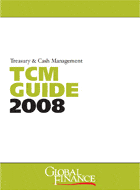 The old adage, “Cash is king,” has rarely been more true. As banks reassess their credit relationships with corporate customers, with a view to maintaining those relationships that are more profitable and less risky, corporates, particularly those in tiers 2 and 3, will find it increasingly difficult to source lines of credit needed for expansion and investment.
The old adage, “Cash is king,” has rarely been more true. As banks reassess their credit relationships with corporate customers, with a view to maintaining those relationships that are more profitable and less risky, corporates, particularly those in tiers 2 and 3, will find it increasingly difficult to source lines of credit needed for expansion and investment.
At the same time, liquidity management techniques that enable treasurers to make rapid and accurate assessments of available cash and to better control and optimize yields on idle cash balances are more important than ever before.
We look at how treasurers should invest their money in such difficult times. Should they focus on safer investments, investment yields or short-term cash positions? Should they also re-evaluate their existing liquidity management structures to ensure they are minimizing idle cash balances?
The credit crunch’s impact, however, goes beyond pure financials. It is also affecting relationships between banks and their corporate clients as those banks in financial difficulty shed some of their clients, along with staff, in order to “de-stress” themselves. Corporates are also reassessing their relationships with banks. In recent years, banking relationships have come under increasing scrutiny as corporate treasurers look to rationalize the number of banks they work with in order to elicit greater processing efficiencies and enhanced liquidity management. In a post-credit-crunch environment, companies are also evaluating their banks from a counterparty risk and credit point of view and looking to banks for other solutions that will help optimize working capital.
It is no surprise then, given the more difficult climate, that banks are turning to non-traditional lines of business—e-invoicing, for example—to try to replace the revenues lost as their bread-and-butter businesses—transaction processing and trade financing—become increasingly commoditized. The latest buzzwords in cash management are e-invoicing and supply chain financing, and the two are related as more banks seek to capture information pertaining to approved invoices in order to provide more competitive forms of financing to a buyer’s network of suppliers.



